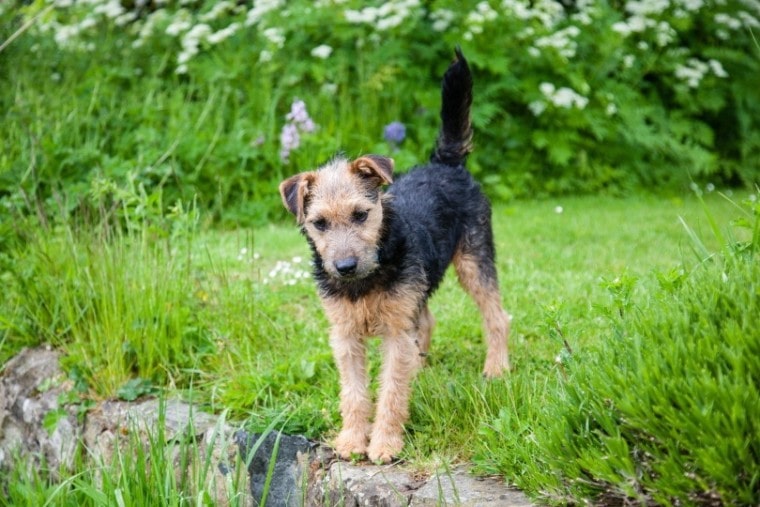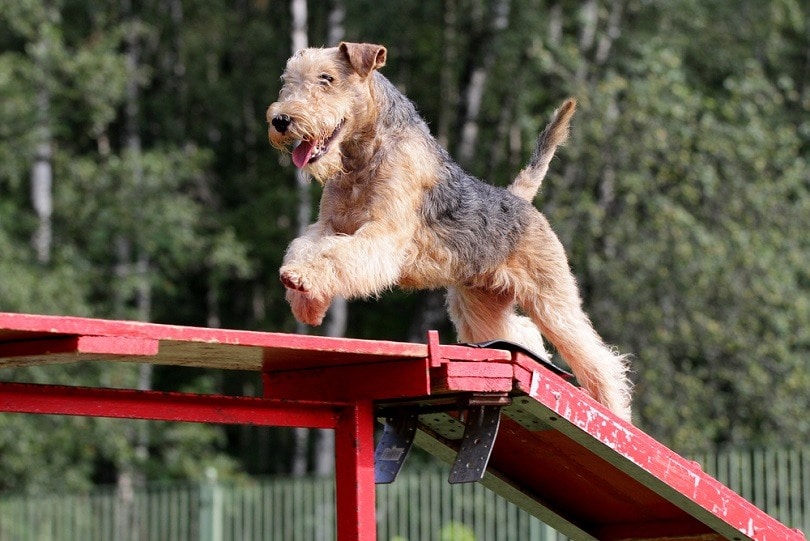
Click Below to Skip Ahead
The Lakeland Terrier, affectionately known to some as a “Lakie”, is a bold and engaging small breed dog. Often described as a “big dog in a little dog’s body”, the Lakeland Terror was historically bred to hunt foxes and protect flocks of sheep from predation.
Breed Overview
Height:
13-14 inches
Weight:
15-17 pounds
Lifespan:
12-15 years
Colors:
Blue, black, liver, red, wheaten, tan
Suitable for:
Active owners, homes with secure yards, patient trainers
Temperament:
Affectionate, confident, curious, playful
Today, the Lakeland Terrier is well known for its regal posture, adorable upright tail, and fashionable facial hair. While some still use this breed for working purposes, you will often find them as successful show dogs and loving members of many families.
These steadfast terriers are strong-willed and can be challenging to train. Still, with knowledge, patience, and experience, they can become polite, well-behaved, and perfectly socialized. Let’s delve more into the unique traits of this beautiful breed to find out if one would be the right fit for your home.
Lakeland Terrier Characteristics
Lakeland Terrier Puppies

Lakeland Terriers are a rare and sought-after breed. Be cautious of strangely low prices, many puppy mills or unethical breeders sell them for low prices but will not take care of the puppies and might sell you an unhealthy dog.
Due to their rarity, Lakeland Terrier puppies do not often end up in shelters. But rarely, they may crop up. Looking around local shelters for one of these dogs, you may be able to find a Lakeland Terrier. Due to their profitable breeding, you are more likely to find an adult Lakeland Terrier in a shelter that is a retired and unwanted breeder. This can be the sad reality of some breeding dogs, but adopting an older Lakeland Terrier can ensure it has a loving home for the rest of its years!
Temperament & Intelligence of the Lakeland Terrier
Lakeland Terriers have a reputation for being a thoroughly rewarding dog breed. They are affectionate, loyal, adventurous, and playful. They tick all the boxes of families looking for an entertaining and engaging addition to their home.
A terrier through and through, the Lakeland Terrier is too intelligent for its own good! Their curiosity and independence will make them prone to becoming bored, always on the lookout for a challenge.
This intelligence makes them extremely fun to share life with. Their zest for life will keep you on your toes and bring around continuous surprises. The Lakeland Terrier will be endlessly devoted to their family but prefers to be treated with the respect of an equal and not dominated into submission.
In addition, this fierce loyalty puts the Lakeland Terrier into the sacred position of a guard dog. They will take their protective duties very seriously, alerting their families to perceived threats to the home.
Their stubborn nature can be challenging to impatient and inexperienced owners. Still, a well-trained and socialized Lakeland Terrier will be well behaved and polite.
Are These Dogs Good for Families? 👪
Absolutely! The high-energy and go-getter attitude of the Lakeland Terrier drives them to be attracted to the youth and spark of children. In saying this, they must be treated with respect, so they are best suited to older, more responsible children who can understand their basic body language.
As a terrier, this breed loves to be part of a pack and will enjoy the company of a family setting. This pack mentality will have the Lakeland Terrier identifying a pack leader, and they have a tendency to bond more with one member of the family than others. Fortunately, this does not mean they will be unkind to others; instead, they will have a preferred person. This person will usually be the one that takes them on all the adventures!

Does This Breed Get Along with Other Pets?
Lakeland Terriers tend to mesh well with other dogs. But be warned, these strong-willed dogs do not back down from challenges, so problems may arise with other dominant dogs. They will happily find companionship with easy-going dogs.
Due to their high prey drive from hunting genetics, the Lakeland Terrier does not always do well with other small pets. Cats, rabbits, and hamsters resemble the natural prey of this breed, and their tendency to run can spark the hunting instinct in the Lakeland to chase.
They can learn to co-exist with some serious training and socialization. Still, they should never be trusted to get along and to be alone together. A Lakeland Terrier is best kept away from other small pets.
Things to Know When Owning a Lakeland Terrier:
Food & Diet Requirements 🦴
Ensure you provide a Lakeland Terrier with a diet that will fuel their high-energy lifestyle. When picking what kind of kibble for this breed, look for a minimum of 20% protein. Protein will ensure the muscles of a Lakeland Terrier are in prime condition. A good diet will provide a small terrier’s frame with the energy to handle the large output.
Treats can be provided for training purposes but should be in moderation to reduce the risk of obesity. A raw bone can make a tasty treat to occupy the Lakeland Terrier’s time, but watch them closely as they are likely to try and bury it to save it for later! Never feed cooked bones as these are prone to splitting and causing internal damage.
Exercise 🐕
Exercise is vital for the well-being of a Lakeland Terrier, this breed needs about 60 minutes a day. Long daily walks are required and reasonably regular adventures where your terrier can explore new sights, smells, and sounds.
Without sufficient exercise, the excess energy of the Lakeland Terrier can cause behavioral issues in the home and lead to an overweight dog. Keep this breed busy and active to promote mental and physical well-being.
The Lakeland Terrier has the perfect combination of energy and intelligence to make them excellent sports dogs. Consider engaging in sports such as hunting or agility with your Lakeland Terrier to really access their full potential.
Training 🎾
One would likely assume that such an intelligent breed would be a breeze to train. Unfortunately, this is not quite the case! The Lakeland Terrier is definitely competent enough to understand what is being asked of them in training sessions, but they are also so strong-willed they often will do what they please.
A strong, firm, and fair trainer is needed for basic Lakeland Terrier training. Provided with consistency and challenges, these terriers can really enjoy their training sessions due to their drive to explore and learn. Make sure you provide plenty of variance in training to keep this dog engaged and drive.
Consider taking a Lakeland Terrier to formal training sessions to help you get a grip on their independent spirits. The key is to learn what it is that motivates them to perform. Their independent thoughts of good behavior may differ from yours!
Grooming ✂️
One attractive bonus to Lakeland Terriers is that they shed very little. This is great for those who can’t tolerate excess dog fur dander and those who wish to keep a clean house.
A Lakeland’s coat is undoubtedly beautiful but a lot different than what many inexperienced owners are used to. Their beautiful double coat sits in loose curls that hold onto any shedding fur, which can become matted quickly. Brushing every few days is required to remove this fur and keep the coat sleek.
Every few months, a Lakeland Terrier should be clipped and trimmed. Enthusiasts of this breed take the extra mile and engage in “hand-stripping” the coat to reduce the risk of matting and improving overall appearance.
This process is time-consuming and more uncomfortable for the dog. It can be hard to find a groomer who has experience with this type of care. In any matter, a regular clipping is perfectly fine to maintain a soft and tidy coat.
Health and Conditions 🏥
The Lakeland Terrier is a hardy breed. There are no known conditions that are more prevalent in this breed due to their genetics. They will still be at risk of general diseases and disorders, particularly as they age. Their active lifestyle may put their body at the risk of muscle wastage in old age.
Male vs Female
There is very little difference between a male and female Lakeland Terrier. The males will be ever so slightly larger, but only by a couple of pounds. Both will make rewarding additions to families. You will only notice a real difference in gender if you choose to keep your dog intact.
Unspayed females will be prone to mood swings through their cycling bodies. She will also come into estrus or “heat” up to twice a year. During this time, she will bleed and because moody in the search for a mate.
Unneutered males may be more boisterous, particularly in the presence of females. They may also “mark their territory” more, with regular spraying behavior observed.
When choosing a gender, you should take into consideration these specific behaviors. These mating-related traits will be much less prevalent if you get your Lakeland desexed.
3 Little-Known Facts About the Lakeland Terrier
1. Lakeland Terriers are very rare.
In the United Kingdom, where Lakeland Terriers originated, this breed is considered a “threatened native breed”, with only 145 individuals registered in 2020.
The Lakeland Terrier is also sparse in the United States, ranking only 145 out of 193 breeds registered with the American Kennel Club in 2019.
It’s no wonder these feisty dogs come with a big price tag considering they are a dwindling breed. While you may pay a reasonable price to have one of these unique breeds join your family, you sure will get a lot of attention at the dog park!
2. Lakeland Terriers are excellent burrowers.
Lakeland Terriers were originally selectively bred to hunt down foxes that preyed on English farmer’s sheep. Foxes would eat the lambs during the spring lambing period, so Lakeland Terriers would be put to work to hunt them down.
Foxes are extraordinary burrowers, so the Lakeland Terrier is well known for its ability to dig exceptionally deep into burrows to track down foxes. It’s not only foxes that this terrier can search for; these dogs have also proved helpful in hunting otters and other vermin.
In fact, the first-ever president of the Lakeland Terrier Association claimed that his Lakeland Terrier dug into an otter burrow 23 feet below the ground! An incredible feat, no doubt.
Don’t let this digging instinct put you off this high-energy dog. Provided with adequate training and the ability to express its natural instincts out and about, you will be able to protect your lawn from being the target of some serious destruction.
3. They’re known by many names.
Before they took up their name, the Lakeland Terrier, this breed was called many different things! Various names included Patterdale, Cumberland, Westmoreland, and Fell Terrier. These names were references to the counties that bred and used these nifty terriers for working purposes.
The name Lakeland Terrier became the recognized breed name in the late 1920s. Still, the breed started to come into existence under various names in the 20 years proceeding. Lakeland Terrier is an ode to the Lake District in England, where this breed was first officially recognized.
Final Thoughts
This small breed packs a big punch. Lakeland Terriers offer all the benefits of a compact dog: low-shedding, space-saving, and adaptable with the bonus of a remarkable personality. This fascinating dog will bring you and your family absolute joy and companionship. Well-suited to a highly active lifestyle, the Lakeland Terrier makes one of the best adventure buddies!
Keep in mind their strong-willed personalities can bring about challenges. Still, they can be overcome with some tenacity to foster a loving and rewarding relationship with the Lakeland Terrier.
Featured Image Credit: eventsfb, Pixabay









